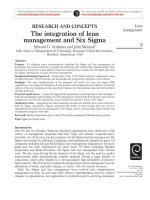The architecture of computer hardware and systems software an information technology approach ch16
Bạn đang xem bản rút gọn của tài liệu. Xem và tải ngay bản đầy đủ của tài liệu tại đây (1.37 MB, 40 trang )
Chapter 16
File Management
The Architecture of Computer Hardware
and Systems Software:
An Information Technology Approach
3rd Edition, Irv Englander
John Wiley and Sons 2003
Introduction to Files
Files
Collection of data
Require a one block minimum
Associations to programs
Logical view vs. Physical view
Sequential vs. Random access
Contiguous vs. Non-contiguous
Chapter 16 File
16-2
Database File – Table Image
Chapter 16 File
16-3
Database File – Form Image
Chapter 16 File
16-4
Database File – Stream Image
Closer to physical representation of file
Chapter 16 File
16-5
Logical View vs. Physical View
Chapter 16 File
16-6
File Management System
Provides a logical view for the user and hides
the physical implementation
Manages directory structures and space
allocation for each I/O device
Permits manipulation of data within a file
Requests data transfers from I/O device
drivers
File security and protection of file integrity
Chapter 16 File
16-7
File Management and I/O Functions
Separation between the two allows
1.
I/O devices can change while keeping the file system the same
2.
Redirecting of data is simple
Chapter 16 File
16-8
File Manager Request Handling
Chapter 16 File
16-9
File Operations
File as a whole
Copy, Move
List, Print
Load and execute a program
Load file into memory
Store file from memory
Append data from memory to file
Compile, assemble a file
Chapter 16 File
16-10
File Operations
Within a file
Open a file
Read a number of bytes from file
Write a number of bytes to a file
Move the file pointer forward or backward
Move file pointer to beginning of a file
Close a file
Chapter 16 File
16-11
File Operations
Record Storage
Retrieve a record (read)
Store a record (write)
Add a record to a file
Delete a record
Modify contents of a record
Chapter 16 File
16-12
File Directory Operations
File Directory
Create a new (empty) file
Move a file from one directory to another
Rename a file
Append one file to another
Delete a file
Chapter 16 File
16-13
File Access Methods
Sequential Access
File is read in sequence from beginning to end
Majority of all files
Program source and binary files
Random Access
Assumes file is made up of fixed length logical records
Hashing is a common method used to calculate the location
of an internal logical record
Indexed Access
Additional means for accessing and viewing records in a file
Key indexes
Chapter 16 File
16-14
Physical File Storage
Contiguous
Non-contiguous
Linked
Indexed
Examples
DOS/Windows FAT
UNIX i-nodes
Windows NTFS
Free space management
Chapter 16 File
16-15
Contiguous Storage Allocation
Assign blocks (all in a row) to hold the file
Access is simple for both sequential and
random methods
Disadvantages
Space must be large enough
Have to take into account file growth
May need to be moved if it outgrows its space
Fragmentation of disk
Allocation strategies to minimize fragmentation
First-fit, best-fit
Eventually disk becomes fragmented
Chapter 16 File
16-16
Contiguous Storage Allocation
Chapter 16 File
16-17
Linked Allocation
Non-contiguous
Each block contains a link to the next physical block
Variant – links in both directions
Advantages
no fragmentation
Adding to a file is easy
Disadvantages
Not usable for random access
Additional disk head searching
Overhead in storing the pointers
Recovery of a defective block is difficult
Chapter 16 File
16-18
Linked Allocation
Chapter 16 File
16-19
MS-DOS FAT
File Allocation Table (FAT)
Table contains the first block of each file on the disk or disk partition
Successive blocks contain a link to the next block
Requires a tremendous amount of space
File integrity can be easily compromised
Chapter 16 File
16-20
MS-DOS FAT
Linked Allocation
and File Allocation
Table
Chapter 16 File
16-21
Indexed Allocation
Non-contiguous
All link pointers are stored together in a single
block called the index block
One index block per file
Advantages
No fragmentation
Can be used for random access
Disadvantage
Slower due to additional access of the index block
Additional disk head searching
Recovery of a defective block is difficult
Chapter 16 File
16-22
Indexed Allocation
Index blocks for indexed allocation of linked files
shown in MS-DOS FAT example
Chapter 16 File
16-23
Unix i-nodes
Indexed file allocation
Index block contains
File attributes
10 direct blocks
1 single indirect
1 double indirect
1 triple indirect
Advantages
Fast for small blocks
Can accommodate very large files – 100’s of
gigabytes
Chapter 16 File
16-24
Unix i-nodes
Chapter 16 File
16-25









